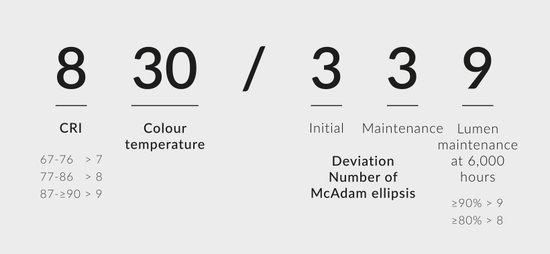All you need to know about LED photometric code
Download the PDFEvery LED system has a photometric code. But what do these 6 numbers mean and what are they for? Let’s find out.
What is the photometric code?
Used for LED and fluorescent lighting, the photometric code provides important information about the colour emitted by a light and its lifespan.
The photometric code has three uses:
- It indicates the white colour temperature: cold (bluish white) or warm (yellowish/reddish white)
- It defines the ability to render different colours (CRI)
- It guarantees manufacturer’s claims are consistent, reliable and accurate.

The photometric code provides several pieces of information, including the colour temperature of the LED.
Lighting’s photometric code: 6 numbers and a whole lot of information
A LED’s photometric code consists of 6 numbers, divided into two by a ‘/’.
On the left, 3 numbers indicate the light’s colour:
- The CRI, or Colour Rendering Index, expressed by a number between 0 and 9
- The correlated colour temperature, given in degrees Kelvin divided by 100
On the right, 3 numbers indicate how well the light is maintained over time:
- The initial colour deviation, in the number of McAdam ellipsis
- Its deviation after 6,000 hours
- The lumen maintenance value at 6,000 hours

|
Useful info CRI: 7 to 9 |
Photometric code and LED lighting: be personal
The photometric code is vital for consistently defining the quality and longevity of lighting in a way that can be compared with the claims of each lighting’s manufacturer.
But in the context of public LED lighting, it can sometimes be a bit vague. In the example above, why talk about 6,000 hours when a diode’s lifespan is more in the region of 50,000 hours? The value at 6,000 hours is used to determine the lifespan of diodes.
Another hitch with the photometric code is the deviation of the LED’s characteristics (data) in various working temperatures. For this, we advise referring to the manufacturer’s datasheet.
At LEC, we have concerns about the accuracy and reliability offered by the standardised photometric code provided by manufacturers. However, what we care about most is personalising our systems to the individual. We ensure the photometric characteristics address the specific needs of each project in order to offer the most appropriate lighting solution. To help you pick the right product, we provide photometric codes on all our datasheets.
To find out more about our lighting solutions, check out our new 2017 product brochure.
-
Download the PDF
- Published on 19 September 2016
- Amended on 04 November 2016
- Categories: Lighting techniques - Norms & Quality
- Tags : colour rendering index - colour temperature - LED - photometric code

